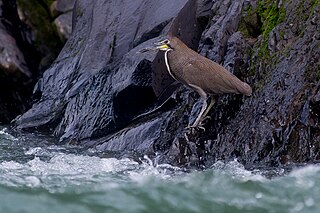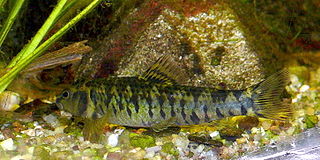
The zebra shark is a species of carpet shark and the sole member of the family Stegostomatidae. It is found throughout the tropical Indo-Pacific, frequenting coral reefs and sandy flats to a depth of 62 m (203 ft). Adult zebra sharks are distinctive in appearance, with five longitudinal ridges on a cylindrical body, a low caudal fin comprising nearly half the total length, and a pattern of dark spots on a pale background. Young zebra sharks under 50–90 cm (20–35 in) long have a completely different pattern, consisting of light vertical stripes on a brown background, and lack the ridges. This species attains a length of 2.5 m (8.2 ft).

Pseudoplatystoma is a genus of several South American catfish species of family Pimelodidae. The species are known by a number of different common names. They typically inhabit major rivers where they prefer the main channels and tend to stay at maximum depth, but some species can also be seen in lakes, flooded forests, and other freshwater habitats. They have robust bodies, and are important food fish.

The reticulated swellshark is a catshark of the family Scyliorhinidae. The Reticulated swellshark is found in the western Pacific Ocean between latitudes 21° N and 28° S, at depths between 220 and 450 m. It is a blunt snouted shark with an inflatable stomach, narrow eye slits and a pattern of spots and lines covering its body. It can grow up to 80 cm in length.

The barred conger is a species of conger eel that lives in the tropical western and central Indo-Pacific region. It is also known as the barred sand conger. It is a bottom-dwelling fish and is found in the waters around Madagascar, Indonesia, the Marshall Islands, Hawaii and Tahiti and some other island groups.

The fasciated tiger heron is a species of heron in the family Ardeidae. It is present in southern Central America and parts of northern and central South America, where its natural habitat is rivers.

Pseudoplatystoma fasciatum or barred sorubim or barred catfish is a species of long-whiskered catfish native to the Suriname, Corantijn and Essequibo. The nocturnal predator feeds mainly on other fish and crabs. Females reach a more notable size. They become sexually mature at 56 cm (22 in), males at 45 cm (18 in) and this species reaches a maximum length of 90 cm (35 in) TL. Fecundity seems to be estimated at 8 million eggs per kg, but was recently measured in aquaculture at a lower, and more likely number of 150,000 eggs laid per kg.
Dipteropeltis hirundo is a little-known species of fish louse. It is an ectoparasite of fish in South America, including piranhas and Pseudoplatystoma fasciatum.
Enneapterygius fasciatus, known commonly as the tiny threefin or the banded triplefin, is a species of triplefin blenny in the genus Enneapterygius. It was originally described by Weber in 1909, under the name Tripterygium fasciatum, which was later renamed Tripterygion fasciatum. It is a tropical blenny found in coral reefs in the Indian and western Pacific Oceans, and has been described from East Africa to Papua New Guinea, the Solomon Islands, and Taiwan. E. fasciatus has been recorded swimming at a depth range of 1–25 metres (3.3–82 ft). Male E. fasciatus can reach a maximum length of 3 centimetres.

Characidium fasciatum, the darter characin, is a fish in the family Characidae.
Melanostoma fasciatum is a species of hoverfly found in New Zealand, where it is common in agricultural fields and gardens. Locally dense populations of this hoverfly species might effectively reduce pest infestation. Hence, they are perhaps an effective natural and non-toxic bioagent that may control and reduce aphid and small caterpillar populations.
Protonarthron is a genus of longhorn beetles of the subfamily Lamiinae, containing the following species:
Compsosoma fasciatum is a species of beetle in the family Cerambycidae. It was described by Monné in 1980. It is known from Brazil.
Protonarthron gracile is a species of beetle in the family Cerambycidae. It was described by Stephan von Breuning in 1936.
Protonarthron indistinctum is a species of beetle in the family Cerambycidae. It was described by Stephan von Breuning in 1938. It is known from the Democratic Republic of the Congo.
Protonarthron diabolicum is a species of beetle in the family Cerambycidae. It was described by James Thomson in 1858.
Protonarthron dubium is a species of beetle in the family Cerambycidae. It was described by Hintz in 1911.
Protonarthron microps is a species of beetle in the family Cerambycidae. It was described by Jordan in 1903.
Protonarthron olympianum is a species of beetle in the family Cerambycidae. It was described by Per Olof Christopher Aurivillius in 1913.
Protonarthron subfasciatum is a species of beetle in the family Cerambycidae. It was described by Jordan in 1894.
Anobrium fasciatum is a species of beetle in the family Cerambycidae. It was described by Galileo and Martins in 2002. It is known from Brazil.








